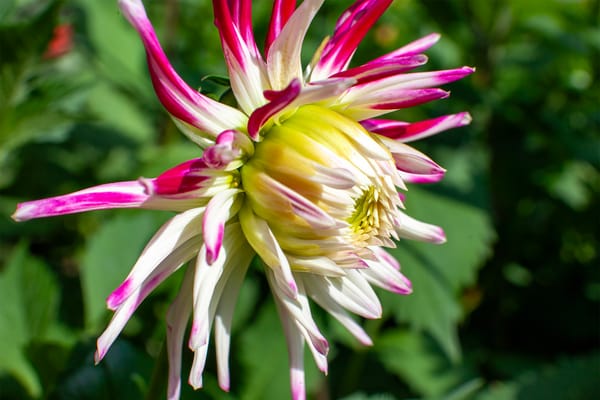In the world of dahlia growing, there’s a quiet art to salvaging the plants that others might discard — the weak-stemmed treasures, the rare cultivars on the brink, or the once-prized stock threatened by storm, pest, or virus. Among expert growers, grafting and rescue techniques are more than botanical curiosity; they’re lifelines for preserving cherished plants and ensuring the health of a garden’s future.
The Art of Grafting Dahlias
Why Graft?
Dahlia grafting is an age-old practice adapted for modern challenges. At its heart, grafting joins a scion — a healthy shoot or bud from a desired variety — onto the rootstock of a vigorous, healthy plant. For Cornish growers working with cherished family lines, rare cultivars, or exhibition plants, grafting provides a way to sustain weaker varieties or propagate a standout specimen with poor tuber health.
Common Grafting Techniques
- Splice (Whip) Grafting: Ideal for matching stem diameters, this method makes a clean, angled cut on both scion and rootstock, secured with grafting tape. It’s a straightforward technique often used with soft, herbaceous stems in early spring.
- Cleft Grafting: Here, a vertical split in the rootstock allows a wedge-shaped scion to be inserted. This is preferred when scion and rootstock diameters differ or with firmer growth.
- Side (Veneer) Grafting: The scion is placed into a shallow cut along the rootstock’s side — perfect when diameters mismatch or direct alignment isn’t possible.
Success with Grafting: The Essentials
Grafting works best in a humid, frost-free environment at around 18–21°C (65–70°F). Alignment of the cambium (the plant’s growth layer) is critical — a fraction off, and the graft may fail. Once secured, grafts need steady humidity, ideally in a propagator or under a plastic cover, to prevent drying and encourage healing.
Patience pays. With careful handling, new grafts begin to knit within 2–3 weeks, after which they can be hardened off and prepared for planting out.
The Rescue Mission: Salvaging Damaged or Ailing Dahlias
When Disaster Strikes: Graft-to-Rescue
If a dahlia’s tuber begins to rot or its crown suffers damage, taking a healthy shoot and grafting it onto a sturdy rootstock can save the variety from complete loss. This is particularly valuable for rare or sentimental plants that can’t be easily replaced.
Vegetative Propagation for Rescue
For less critical cases, basal cuttings or meristem-tip cuttings may revive a weak plant. These methods encourage fresh growth without the need for full grafting but demand careful propagation in controlled environments.
Caring for Borderline Plants
Sometimes, dedicated care — improved drainage, careful feeding, vigilant pest control — can coax a struggling plant back to vigor. Regular inspection and a bit of extra attention often make the difference between a write-off and a garden comeback.
Facing the Viral Threat: When to Rescue and When to Remove
The Grim Reality of Virus-Infected Dahlias
Dahlia viruses are insidious. Once infected, a plant rarely recovers — visible signs include yellow streaks, mosaic patterns, stunted growth, and distorted blooms. Infected plants act as reservoirs, spreading disease to healthy neighbours via tools, sap, or pests like aphids.
Rescue Through Removal
The most effective response? Immediate removal and destruction. This harsh but necessary step protects the wider collection. Disinfecting tools and surfaces with a 10% bleach solution is essential to prevent further spread.
Tissue Culture: The Last Resort for the Irreplaceable
For cultivars of exceptional value, tissue culture — particularly meristem-tip culture — offers a slim chance of rescue. Conducted in specialist labs, this method harvests virus-free cells from the plant’s youngest growth tips, potentially generating clean stock. It’s costly, technical, and often reserved for breeders or heritage conservation.
The Unsung Hero: Choosing the Right Rootstock
A graft is only as strong as its rootstock. The ideal candidates? Healthy, virus-free plants of vigorous growth, usually common or robust garden dahlias with proven performance in local conditions. Matching stem diameter between scion and stock increases the likelihood of a successful union.
For Cornish gardens, rootstock grown under local conditions — resilient to the southwest’s damp spells and occasional salt breezes — offer the best foundation for thriving grafts.
Graft Timing and Seasonal Success
The Golden Window: Late Winter to Early Spring
Grafting in late winter to early spring, when plants awaken from dormancy but before active growth, gives the best chance of success. Tubers can be forced indoors to produce strong shoots for grafting, avoiding the pitfalls of outdoor unpredictability.
Avoiding the Pitfalls of Summer and Autumn Grafting
Mid-season grafting risks failure due to rapid water movement, pest pressure, and the stress of flowering. Autumn attempts often fail as plants enter dormancy, reducing sap flow essential for union formation.
Grafting Gone Wrong: Troubleshooting and Lessons Learned
Common signs of graft failure include wilting scions, swelling or bulging at the graft site, yellowing leaves, or premature separation. Most causes boil down to three culprits:
- Poor cambium contact
- Incompatible scion and rootstock pairing
- Suboptimal environmental conditions
Success lies in mastering the basics: clean cuts, precise alignment, steady humidity, and vigilant care. Practice, record-keeping, and careful selection build confidence — and skill — over time.
Grafting and Rescue in the Cornish Garden Context
Cornwall’s gardens are shaped by their resilience — thriving on wind-swept coasts, in sheltered valleys, or within stone-walled plots. Grafting and rescue work echoes that same spirit: a careful blend of patience, practical skill, and a gardener’s refusal to give up on a beloved plant.
For the passionate grower, these techniques offer a powerful toolkit — not just for saving dahlias, but for cultivating a deeper connection to the living history and future of the garden.











